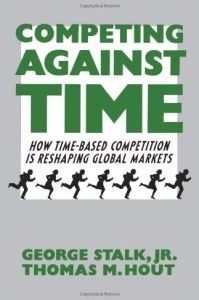Join getAbstract to access the summary!

Join getAbstract to access the summary!
George Stalk, Jr. and Thomas M. Hout
Competing Against Time
How Time-Based Competition Is Reshaping Global Markets
Free Press, 1990
What's inside?
The time has come for your company to pay more attention to time.
Recommendation
This classic by consultants George Stalk Jr. and Thomas M. Hout is at once blunt and subtle, dated and timely. It is blunt in its direct focus on its core topic: why time is central to business. It is subtle in the way it approaches the subject from many angles, documenting and illustrating its thesis in large and small ways. Stalk and Hout understand elements of business that many people do not grasp, such as the role of self-awareness and vision even in apparently concrete processes, such as a factory production cycle. Because the book first came out in 1990, its discussions of things like the fax machine as cutting-edge technology will seem dated. Look past such examples, because its core insights about time’s role in business are timeless, as are its lessons about how time relates to customer service, innovation, finance and organizational structure. getAbstract recommends this highly useful classic to those interested in workflows or innovation, to business history students and to executives who want to make their businesses more effective.
Summary
About the Authors
George Stalk Jr. and Thomas M. Hout are senior advisers at the Boston Consulting Group, where Stalk is also a fellow. His books include Five Future Strategies You Need Right Now.

















Comment on this summary